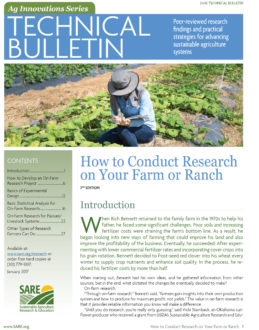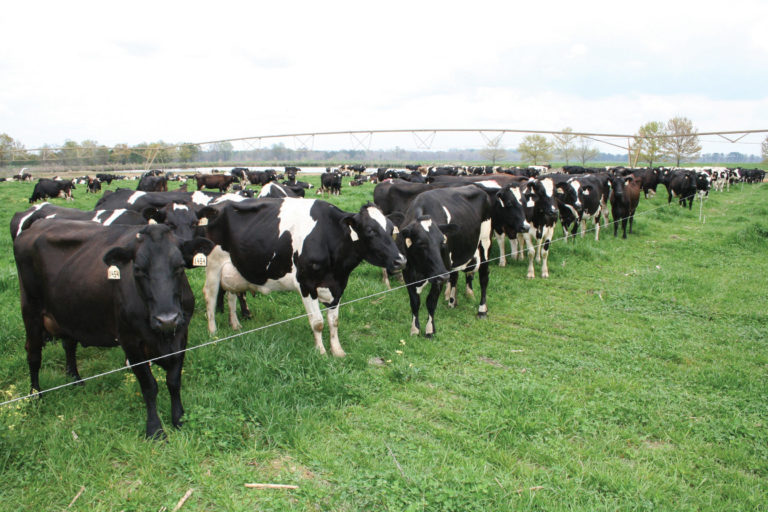On-Farm Research Answers Key Questions While Making the Switch to a Pasture-Based Dairy System
Although Tom Trantham was one of South Carolina’s top dairy producers back in the 1980s, his business, 12 Aprils Dairy, was struggling. He ran a typical confined feeding operation and his feed bill alone ate up 65 percent of his gross income. “Financial advisors told me to get out of the business,” Trantham recalled. “They said there was no way for me to make it. Those were dark days; I’d wake up and think maybe the place had burned down or all the cows had died in the night and I’d be free.”
Then in April 1989, by chance, his cows broke out of the feeding area into a seven-acre field full of natural lush spring growth—lamb’s quarters, ryegrass, a little clover and fescue. Trantham noted a two-pound average increase per cow in milk production the next day, and since then, things have never been the same. Thinking maybe the cows were trying to tell him something, Trantham opened all the gates on his farm and began the transition away from a confined feeding operation toward an entirely new pasture-based system. For Trantham, this transition raised some important questions:
- What types of plants (crop and forage species) can be grown to provide adequate and nutritious year-round grazing for the cows?
- Can alfalfa, or annual grains such as sorghum and millet, be included in the grazing sequence?
- Can this variety of crops be grown using sustainable agriculture methods (e.g., manure as nutrient source, no-till, minimizing the use of chemicals)?
- Is the new pasture-based system economical when compared to a confined-feeding operation?
Trantham approached Clemson University professors Jean Bertrand and Fred Pardue to help him find some answers. Together, they obtained a Southern SARE Research and Education grant to determine the feasibility of a minimum-input, financially sound grazing dairy. From 1994 through 1997, the SARE-funded researchers monitored Trantham’s practices and recommended changes based on their findings. At the end of the project they had a body of scientific knowledge to help other farmers, and Trantham had a successful grazing dairy system.
“When I first started experimenting with grazing, production dropped to 15,000-pound average, but I still paid my bills because of the decreased feed costs,” Trantham said. “Profits continued to improve as I moved further away from conventional dairying.” Today, his milkers consistently top an 18,000-pound average, and he thinks they can do even better as he tweaks the system with irrigation, smaller paddocks and other improvements.
As a cooperator on a Southern SARE Professional Development Program project headed by Steve Washburn of North Carolina State University, Trantham toured grazing dairies in Ireland, seeking more ways to improve his system. “That’s where I learned I needed to reduce my paddock sizes,” he recalled. “I saw firsthand how moving them every day, or even every milking, can minimize paddock damage and allow faster regrowth. I learned a lot about irrigation options and came home to install more than $10,000 worth of irrigation on my farm, a risk I would have considered reckless in the days when I would have invested that much and more in feed supplements. But unlike feed supplements, the irrigation will pay off for the rest of my life, not just for this season.”
Trantham also experimented with some lane materials as part of a Southern SARE Producer grant project. He continues to try new ideas and evaluate every part of the system for efficiency and cost effectiveness.
Through the SARE grants and a process of continuous improvement, 12 Aprils is now a thriving and profitable dairy. As the name of his dairy implies, Trantham’s goal is to provide an April-type feed for his cows every month of the year. He achieves that by planting his 29 paddocks with a succession of crops that provide the type of growth the cows are most hungry for and that boost milk production. Trantham is quick to note that his emphasis on year-round crops makes his system an atypical pasture-based, rotational grazing system. It is not for everyone, and the crop mix is quite specific to his farm and geographic location.
“A lot of times, the questions we ask…the answer is not what we were looking for,” Trantham said. “So, rather than asking what rye variety is best to plant in South Carolina, I found out that there are…other ryes, and you can find out that some of those come up quicker or last longer or take more cold. You need to know what performs better for your farm…and you can learn that from your own on-farm research.”
LEARN MORE
Find a video of Tom Trantham telling his story, reports from his SARE-funded projects and detailed information about his grazing system on Trantham's multimedia page.

